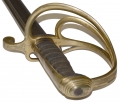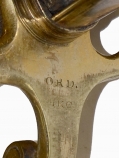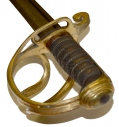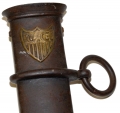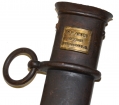site search
online catalog
RARE FIRST PATTERN U.S. M1839 TOPOGRAPHICAL ENGINEER’S SWORD: THE ONLY KNOWN U.S. INSPECTED EXAMPLE & PROBABLY THE GOVERNMENT MODEL

$17,000.00 SOLD
Quantity Available: None
Item Code: 870-328
The is the rarest of the rare: the only Topographical Engineer officer's saber that is government inspected and is thought by Thillmann to be the “model” sword for the pattern since it bears government inspection stamps on the guard, knucklebow, blade, and scabbard, that tie it all together, but also exhibits a two-branch guard, a quillon finial lacking the star, and unusual solid carrying rings with narrow, squared-off ring bands on the scabbard, in contrast to later production examples (see, U.S. Army Swords 96-100.)
The grip is dark ray skin in excellent condition with dragoon-style twisted wire flanked by a single strand and a ferrule at the bottom decorated with oak leaves and acorns, matching etched motifs on the blade. The brass hilt is heavily gilt, and bears ORD. / H.K.C. inspector marks on inside of the guard below the quillon and J.M. on the inside of the knuckle bow near the sword knot slot. The gilding is lustrous and shows just slight wear on the backstrap from handling and a few slight checks on the pommel cap, which shows a recessed spanner nut, making clear the model’s descent from the 1833 dragoon sabers, as does the configuration of the blade and the use of two-branch guard on this example.
The blade pad is in place on the underside of the guard. The blade etching is visible and legible as a muted silver against the frosted background that has shifted toward gray. The blade bears a J.M stamped on the obverse base of the blade that corresponds with the “J.M.” inside the knucklebow and a “J.M.” on the obverse scabbard drag. with the Ames maker’s address etched above: “N.P Ames / Cutler / Springfield” followed by a palmette/sunburst, branches of oak leaves and acorns, a stand of flags with a liberty cap on pole among them, a trophy of arms, a Sibley-style camp tent with pennant flying from its center pole and other oak branches with leaves and acorns. The reverse is etched with a blank horizontal plaque near the base, likely for a presentation or owner’s name, with oak branches above and a U.S. Shield with “T.E.” and panel with: United States Corps of / Topographical Engineers followed by an Eagle with E Pluribus Unum ribbon, a standing Indian (Tecumseh) with raised tomahawk, and ending with oak branches. The etched panels on both side end in flame points. The edge and point are good. The metal shows a mix of gray and dark gray above the etching.
The scabbard is browned, with pleasing gilt remaining on the Ames maker’s plaque on the reverse reading, N.P. Ames / Cutler / Springfield, just below the trumpet throat, and on the U.S. Shield with T.E. in Old English letters at top on the obverse. The rings are solid, not split, as on later production examples, and the ring bands are narrower and squared. The scabbard drag bears inspectors’ marks as well: “JM” obverse and “ORD / HKC” reverse, linking it to the hilt.
This saber was adopted in 1839 for use by the Topographical Engineers. They had been established as a bureau by the War Department in 1831 as the west and southwest opened up for exploration and the need for cartographers became clear. Initially part of the Corps of Engineers, the “Topos” became an independent unit in 1838, and lasted until early 1863, when they reunited with the Engineer Corps. This pattern was regulation for them from 1839 to 1850 which, along with their low numbers and very active field service makes any example of their weapons difficult to find.
They were a very small and selective group. At their establishment their duties, as distinct from those of the Corps of Engineers, were laid out: “The duties of the Corps shall consist, in surveys for the defense of the frontier, inland and Atlantic, and of positions for fortifications; in reconnoissances of the country through which an army has to pass, or in which it has to operate; in the examination of all routes of communication by land or by water, both for supplies and military movements; in the construction of military roads and permanent bridges connected with them, and, in the absence of an officer or officers of the Corps of Engineers, of military bridges, and of field-works, for the defense of encampments, fords, ferries, and bridges. For which purposes, officers of the Corps of Topographical Engineers shall always accompany armies in the field.”
The corps was selective and elite, drawing from the top of West Point classes and numbering only about 40 officers at their formation and even at the beginning of the Civil War. They had an extensive and important role in the exploration and survey expeditions of the American west and southwest, as well as service in the campaigns and battles of the Seminole War, Mexican War, and the Civil War. It is not surprising then that for a sword they did not adopt the small-sword pattern carried by the Corps of Engineers, but a saber patterned after those carried by dragoon officers, and even then they specified it should have the recently introduced thicker steel scabbard and an even more robust hilt using three branches in addition to the knucklebow. As the only known Topographical Engineer’s sword with government inspection marks and showing elements changed in later production examples, many of the most advanced students of American edged weapons believe this to be the example put together by Ames and sent for approval to Washington. This is a remarkable example of a rare sword significantly involved in the growth of the country. [sr]
~~~~~~~~~~~~~~~~~~~~~~~~~
THIS ITEM, AS WITH ALL OTHER ITEMS AVAILABLE ON OUR WEB SITE,
MAY BE PURCHASED THROUGH OUR LAYAWAY PROGRAM.
FOR OUR POLICIES AND TERMS,
CLICK ON ‘CONTACT US’ AT THE TOP OF ANY PAGE ON THE SITE,
THEN ON ‘LAYAWAY POLICY’.
THANK YOU!
Inquire About RARE FIRST PATTERN U.S. M1839 TOPOGRAPHICAL ENGINEER’S SWORD: THE ONLY KNOWN U.S. INSPECTED EXAMPLE & PROBABLY THE GOVERNMENT MODEL
For inquiries, please email us at [email protected]
Most Popular
Historical Firearms Stolen From The National Civil War Museum In Harrisburg, Pa »
Theft From Gravesite Of Gen. John Reynolds »
Cavalry Carbine Sling Swivel »
Fine Condition Brass Infantry Bugle Insignia »
featured item
12-POUNDER NAPOLEON PENDULUM HAUSSE CANNON SIGHT
This is an essential piece of artillery gear for crews manning the classic Civil War field-piece, the Model 1857 12-Pounder Napoleon. The pendulum hausse rear sight was the often-used replacement for the tangent scale rear sight that needed the… (1231-02). Learn More »









